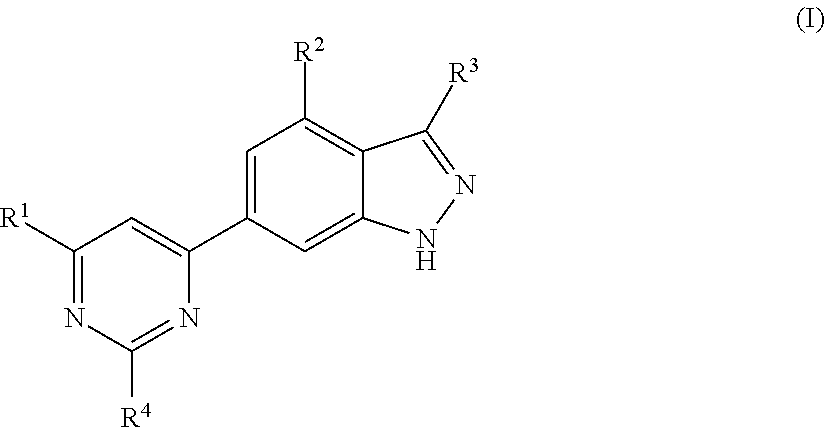Chemical compounds
a technology of pyrimidinyl and derivatives, applied in the field of chemical compounds, can solve the problems of increased apoptosis and tumor cell proliferation, and achieve the effects of reducing tumor cell proliferation and increasing apoptosis
- Summary
- Abstract
- Description
- Claims
- Application Information
AI Technical Summary
Benefits of technology
Problems solved by technology
Method used
Image
Examples
example 1
6-(3-Amino-1H-indazol-6-yl)-N4-phenyl-2,4-pyrimidinediamine
[0626]
[0627]To 4-[2-amino-6-(phenylamino)-4-pyrimidinyl]-2-fluorobenzonitrile (366 mg, 1.2 mmol) in EtOH (10 mL) was added hydrazine monohydrate (1.0 mL, 32 mmol) and the reaction mixture was stirred overnight at 100° C. The mixture was poured onto water and EtOAc. The layers were separated and the aqueous layer was further extracted with EtOAc. The combined organic layers were washed with brine, dried (MgSO4), filtered and concentrated to afford crude product (230 mg). This material was dissolved in EtOH. Hexane was added until a precipitate began to form (a spatula was used to scratch the walls). The mixture was decanted and the solid was dried under vacuum to afford the title compound (100 mg, 26%) as a tan solid. LC-MS (ES) m / z=302, 304 [M+H]+. 1H NMR (400 MHz, CD3OD): δ 6.51 (s, 1H), 7.04 (m, 1H), 7.32 (m, 2H), 7.46 (dd, J=8.6, 1.3 Hz, 1H), 7.66 (m, 2H), 7.75 (dd, J=8.3, 0.8 Hz, 1H), 7.81 (s, 1H).
Intermediate 3
6-Chloro-...
example 2
6-(3-Amino-1H-indazol-6-yl)-N4-(phenylmethyl)-2,4-pyrimidinediamine
[0632]
[0633]To 4-{2-amino-6-[(phenylmethyl)amino]-4-pyrimidinyl}-2-fluorobenzonitrile (367 mg, 1.15 mmol) in EtOH (10 mL) was added hydrazine monohydrate (1.0 mL, 20.4 mmol) and the reaction mixture was stirred overnight at 100° C. The mixture was poured onto water and EtOAc. The layers were separated and the aqueous layer was further extracted with EtOAc. The combined organic layers were washed with brine, dried (MgSO4), filtered and concentrated to afford crude product (280 mg). This material was dissolved in EtOH. Hexane was added until a precipitate began to form (a spatula was used to scratch the walls). The mixture was decanted and the solid was dried under vacuum to afford the title compound (150 mg, 39%) as a tan solid. LC-MS (ES) m / z=332 [M+H]+. 1H NMR (400 MHz, CD3OD): δ 4.59 (s, 2H), 6.29 (s, 1H), 7.23 (m, 1H), 7.28-7.38 (m, 4H), 7.41 (d, J=8.3 Hz, 1H), 7.72 (d, J=8.6 Hz, 1H), 7.75 (s, 1H).
Intermediate 5
4-...
example 3
6-[2-Amino-6-(methylthio)-4-pyrimidinyl]-1H-indazol-3-amine
[0636]
[0637]To 2-fluoro-4-(4,4,5,5-tetramethyl-1,3,2-dioxaborolan-2-yl)benzonitrile (16.5 g, 66.6 mmol) and 4-chloro-6-(methylthio)-2-pyrimidinamine (11.7 g, 66.6 mmol) were added 1,4-dioxane (300 mL) and saturated aqueous NaHCO3 (150 mL) and the mixture was degassed with nitrogen gas for 15 minutes into a sealable tube. Pd(Ph3P)4 (2.3 g, 2.0 mmol) was added, the tube was sealed, and the reaction mixture was stirred overnight at 100° C. The mixture was cooled to room temperature and poured onto water where a precipitate was formed. The mixture was filtered and the solid was transferred to a sealable tube. Dioxane (300 mL) was added followed by hydrazine monohydrate (32.7 mL, 666 mmol) and the reaction mixture was stirred overnight at 100° C. into the sealed tube. The reaction mixture was allowed to cool to room temperature and filtered. The filtrate was poured onto water and filtered again. The aqueous filtrate was poured on...
PUM
| Property | Measurement | Unit |
|---|---|---|
| Electrical conductance | aaaaa | aaaaa |
| Mass | aaaaa | aaaaa |
| Mass | aaaaa | aaaaa |
Abstract
Description
Claims
Application Information
 Login to View More
Login to View More - R&D
- Intellectual Property
- Life Sciences
- Materials
- Tech Scout
- Unparalleled Data Quality
- Higher Quality Content
- 60% Fewer Hallucinations
Browse by: Latest US Patents, China's latest patents, Technical Efficacy Thesaurus, Application Domain, Technology Topic, Popular Technical Reports.
© 2025 PatSnap. All rights reserved.Legal|Privacy policy|Modern Slavery Act Transparency Statement|Sitemap|About US| Contact US: help@patsnap.com



